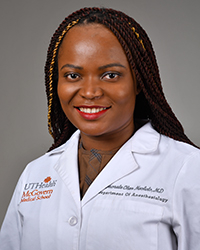
Omonele O. Nwokolo, MD
Achieving racial, ethnic, and gender diversity and inclusion has been an elusive pursuit in medicine. Defining who is ultimately responsible for developing and implementing a plan that ensures an equal opportunity for everyone could be the key to success. But who should take the lead?
This is the question experts will try to answer during Sunday’s debate “Achieving Diversity and Inclusion in Anesthesiology Departments: Whose Responsibility Is it?” Drs. John Butterworth and Omonele O. Nwokolo will offer their arguments for assigning the responsibility to a singular person or allocating the responsibility through delegation.
Dr. Butterworth, Professor and Chair of Anesthesiology at Virginia Commonwealth University School of Medicine in Richmond, will argue that the chair of the anesthesiology department is solely responsible for ensuring diversity and inclusion, and that this duty cannot be delegated. Conversely, Dr. Nwokolo, Associate Professor and Vice Chair for Diversity and Inclusion, Department of Anesthesiology, McGovern Medical School at UTHealth in Houston, will counter that the chair of the anesthesiology department is responsible for diversity and inclusion, but a delegated leadership role is essential.

John Butterworth, MD
Both doctors agree upon the factors that have contributed to the difficulties in achieving diversity and inclusion in the practice of medicine, pointing to traditions and preferences that eliminate candidates who are otherwise well qualified.
“We place unnecessary barriers to enter medical school. We require (candidates) to complete organic chemistry and physics rather than selecting those who seek to become doctors with the skill set that is actually needed, which is the desire to help others and sufficient intellect to master the material,” Dr. Butterworth said. “Instead, we cling to the artificial idea of a ‘meritocracy’ in which we assess ‘merit’ using metrics chosen for convenience (standardized tests).”
Dr. Nwokolo said she agrees with Dr. Butterworth’s assessment.
“The process values more unproven quantifiable metrics than other less quantifiable attributes,” she said. “It’s simpler to have a cutoff set of numbers than put in the work to place value on other things that may make for a better physician. At the end of the day, it is important to ensure that the candidate is able to pass all qualifying examinations, but arbitrary high entry scores should not be the only measure.”
Achieving Diversity and Inclusion in Anesthesiology Departments: Whose Responsibility Is It?
2-3 p.m.
Sunday
Both Dr. Butterworth and Dr. Nwokolo also agree that when diversity and inclusion don’t happen on the general medical level, it’s even more evident in specialty medicine.
“The pipeline into medicine trickles down to anesthesiology,” said Dr. Nwokolo. “Already most medical students find out about anesthesiology later in their medical school career than other specialties. When there is already a paucity of minorities in the applicant pool, it lends itself to further lack of diversity in specialization.”
Dr. Butterworth added that the competition to gain entrance to an anesthesiology residency contributes to the problem, pointing to the lack of diversity in the “professoriate” of anesthesiology and its relation, in part, to artificial restrictions placed on entry to residence programs (minor differences in licensing exam scores).
There are a number of reasons leaders have not been able to successfully implement processes that promote diversity and inclusion, according to Drs. Nwokolo and Butterworth.
“Leaders in medicine, when they have given any attention to diversity management at all, have tended to focus on symbols, affirmative action, etc., which indicates that they don’t get it,” said Dr. Butterworth.
“There is a tendency to politicize issues of diversity and inclusion and a lot of leaders get anxious about appearing to favor one side or the other of the spectrum,” said Dr. Nwokolo. “The reality is there is overall benefit to diversity, good business, health equity, and a healthier population. Step away from tokenism and quotas and do the work that’s needed.”
Where the doctors disagree is who is ultimately responsible for creating a process that ensures equal access for everyone in anesthesiology.
“Managers and leaders—chairs, deans, group presidents—set the tone for their units. It is my opinion that one should not be a dean, departmental leader or group manager if one lacks the skill of diversity management,” said Dr. Butterworth. “It becomes a tough, uphill climb for others to assume the role of ‘diversity champion’ if the individual to whom they report is clueless about diversity management, the value of a diverse workforce, or the underlying issues that have led to lack of diversity.”
“Ultimately the ‘buck stops on top.’ So the leader of the institution or department is ultimately responsible,” said Dr. Nwokolo. “But a CEO who tries to be CFO, CIO, COO, CMO, and all other positions might have a hard time managing said company. There has to be a willingness to delegate and ensure that someone is able to give the full and specialized attention needed to the work of improving diversity and inclusion in our institutions.”
Return to Index